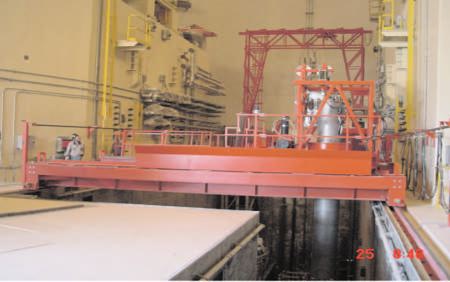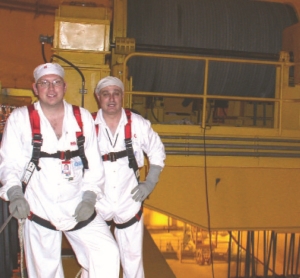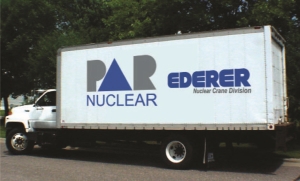
Refueling machine installation in Korea
PaR Nuclear has the experience to offer two levels of service to support installation of new fuel-handling equipment and outage-critical cranes and equipment upgrades. The first level is a “Limited Scope Installation” in which PaR Nuclear takes the technical lead and the customer provides all personnel and equipment necessary to complete the installation on critical path time. The second level is a “Full-Scope Installation” in which PaR Nuclear will provide all of the necessary personnel and equipment for the installation.
PaR Nuclear’s outage support is focused on operability of fuel-handling equipment and outage-critical cranes. Outage support typically consists of pre-outage equipment checkout, preventative maintenance and equipment training and outage planning. During the outage PaR Nuclear supports equipment troubleshooting and repair, as well as the execution of preventative maintenance procedures. Following the outage equipment performance, improvement recommendations are provided in addition to a full outage report. Planning for the next outage may also begin. Outages are supported by a team of qualified field service engineers and technicians who are familiar with all types of fuel-handling equipment and outagecritical cranes.

Outage support in the United States and around the world
PaR Nuclear maintains a spare parts department at the Shoreview,Minn., location. Our spare parts representatives, some with more than 20 years of experience, understand the issues related to spare parts and repair services in the nuclear utility industry. All materials are shipped with requested certifications. PaR Nuclear offers a mobile spare parts inventory (MSPI) of customer-specific spare parts positioned in our trucks and available for use on site during outages. This MSPI option provides immediate accessibility to parts while offering financial savings associated with the reduction of on-site customer spare parts inventory. A MSPI often forms part of an Asset Management Program.
Training is a key part of any successful installation, operational and preventive maintenance program. PaR Nuclear offers training on site or at PaR Nuclear’s Shoreview, Minn., facility and includes equipment operation, mechanical and electrical maintenance and software (PLC and HMI). Our training program has been developed in the topic learning objective (objective based) format to clearly define training topics and deliverables. Test benches in Shoreview offer training on:

Mobile spare parts inventory truck
PaR Nuclear’s Asset Management Program improves the safety and performance of on-site fuel-handling equipment and outage-critical cranes. The Asset Management Program consists of evaluating the ongoing status of the equipment and cranes, establishing appropriate preventative maintenance processes, and developing a MSPI plan, if applicable.
The equipment evaluation identifies obsolete parts, single points of vulnerability and life-cycle management issues. Component histories are reviewed as are past outage reports to determine compliance with current safety and performance objectives. A review of the current preventative maintenance plan and reassessment of part inspection requirements and frequency, component replacement schedule, spare parts inventory, and relative risk assessment for each component provides the content for an improved preventative maintenance plan. The current inventory of on-site spare parts and the MSPI are reviewed and modified to support the other elements of the Asset Management Program.
The value of the Asset Management Program is its role of mitigating safety and downtime risks. The cost of implementing upgrades and repairs is often significantly lower than the cost of downtime and maintenance over the expected useful life of the equipment.